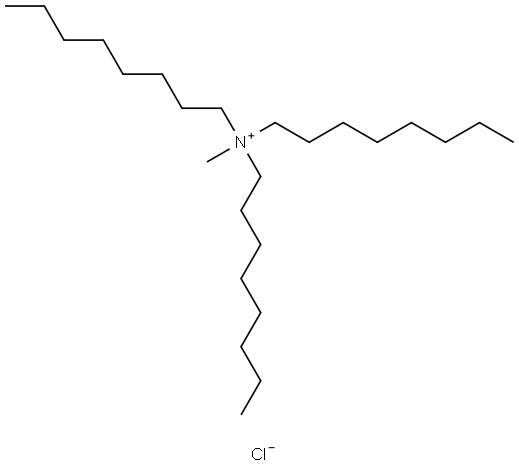| Identification | More | [Name]
Methyl trioctyl ammonium chloride | [CAS]
5137-55-3 | [Synonyms]
ADOGEN 464
ALIQUAT 336
ALIQUAT(R) 336
ALIQUAT(TM) 336
CAPRIQUAT
METHYLTRI-N-OCTYLAMMONIUM CHLORIDE
METHYLTRIOCTYLAMINE HYDROCHLORIDE
METHYLTRIOCTYLAMMONIUM CHLORIDE
TOMAC
TRICAPRYLMETHYLAMMONIUM CHLORIDE
TRICAPRYLYLMETHYLAMMONIUM CHLORIDE
TRICAPRYLYL MONOMETHYLAMMONIUM CHLORIDE
TRI-N-OCTYLMETHYLAMMONIUM CHLORIDE
TRIOCTYLMETHYLAMMONIUM CHLORIDE
1-Octanaminium,N-methyl-N,N-dioctyl-,chloride
aliquat
methyltricaprylylammoniumchloride
methyltrioctyl-ammoniuchloride
n-methyl-n,n-dioctyl-1-octanaminiuchloride
n-methyl-n,n-dioctyl-1-octanaminiumchloride | [EINECS(EC#)]
225-896-2 | [Molecular Formula]
C25H54ClN | [MDL Number]
MFCD00011862 | [Molecular Weight]
404.16 | [MOL File]
5137-55-3.mol |
| Chemical Properties | Back Directory | [Appearance]
viscous colourless to pale orange liquid | [Melting point ]
-20°C | [Boiling point ]
240°C | [density ]
0.884 g/mL at 25 °C(lit.)
| [vapor pressure ]
0Pa at 25℃ | [refractive index ]
n20/D 1.4665(lit.)
| [Fp ]
>230 °F
| [storage temp. ]
Inert atmosphere,2-8°C | [solubility ]
soluble in Chloroform, Hexanes | [form ]
Viscous Liquid | [color ]
Colourless to pale orange | [Odor]
Ammonical | [Stability:]
Stable. Incompatible wth strong oxidizing agents. Hygroscopic. | [Water Solubility ]
Partially insoluble | [Sensitive ]
Hygroscopic | [Detection Methods]
NMR | [BRN ]
4039255 | [InChIKey]
XKBGEWXEAPTVCK-UHFFFAOYSA-M | [LogP]
4.5 at 25℃ | [CAS DataBase Reference]
5137-55-3(CAS DataBase Reference) | [EPA Substance Registry System]
5137-55-3(EPA Substance) |
| Questions And Answer | Back Directory | [Description]
Methyltrioctylammonium chloride is a water insoluble quaternary ammonium salt, which is widely used as a counter ion in solvent extraction of anionic metal complexes. It is widely used as a phase transfer catalyst for the catalytic oxidation of cyclohexene to 1,6-hexanedioic acid. In comparison to traditional method of oxidizing cyclohexanol or cyclohexanone with nitric acid or potassium permanganate, the usage of methyltrioctylammonium chloride is a more environmentally friendly reaction. | [Reference]
N. Pourreza, H. Zavvar Mousavi, Determination of cadmium by flame atomic absorption spectrometry after preconcentration on naphthalene– methyltrioctylammonium chloride adsorbent as tetraiodocadmate (II) ions, Analytica Chimica Acta, 2004, vol. 503, pp. 279-282
|
| Safety Data | Back Directory | [Hazard Codes ]
Xn,N | [Risk Statements ]
R22:Harmful if swallowed.
R38:Irritating to the skin.
R41:Risk of serious damage to eyes.
R50/53:Very Toxic to aquatic organisms, may cause long-term adverse effects in the aquatic environment .
R36/37/38:Irritating to eyes, respiratory system and skin .
R20/21/22:Harmful by inhalation, in contact with skin and if swallowed . | [Safety Statements ]
S26:In case of contact with eyes, rinse immediately with plenty of water and seek medical advice .
S39:Wear eye/face protection .
S60:This material and/or its container must be disposed of as hazardous waste .
S61:Avoid release to the environment. Refer to special instructions safety data sheet .
S36:Wear suitable protective clothing . | [RIDADR ]
UN 2810 6.1/PG 3
| [WGK Germany ]
3
| [RTECS ]
UZ2997500
| [F ]
3-10 | [HazardClass ]
6.1 | [PackingGroup ]
III | [HS Code ]
29239000 | [Safety Profile]
Poison by ingestion and
intraperitoneal routes. When heated to
decomposition it emits very toxic fumes of
NOx, NH3, and Cl-. |
| Hazard Information | Back Directory | [Chemical Properties]
viscous colourless to pale orange liquid | [Uses]
Methyltrioctylammonium chloride can be used:
- As a catalyst in the synthesis of acridine dione derivatives from aromatic aldehyde, dimedone and amines under ultrasonic irradiations.
- As a catalyst in the synthesis of extended π-systems using aromatic aldehydes and methyldiazines.
- As a component of a catalytic system used in the Suzuki-Miyaura cross-coupling reaction of a variety of aryl and heteroaryl chlorides in H2O.
| [Definition]
ChEBI: An organic chloride salt having methyltrioctylammonium as the cation. | [Flammability and Explosibility]
Notclassified | [Purification Methods]
A 30% (v/v) of Aliquat 336 solution in *benzene is washed twice with an equal volume of 1.5M HBr. [Petrow & Allen, Anal Chem 33 1303 1961.] It is purified by dissolving 50g in CHCl3 (100mL) and shaking with 20% NaOH solution (200mL) for 10minutes, and followed by 20% NaCl (200mL) for 10minutes. It is then washed with a small volume of H2O and filtered through a dry filter paper [Adam & Pribil Talanta 18 733 1971]. n-Alkylammonium chloride n=2,4,6. Recrystallise them from EtOH or an EtOH/Et2O mixture. [Hashimoto & Thomas J Am Chem Soc 107 4655 1985, Chu & Thomas J Am Chem Soc 108 6270 1986.] n-Alkyltrimethylammonium bromide n=10,12,16. Recrystallise them from an EtOH/Et2O mixture. [Hashimoto & Thomas J Am Chem Soc 107 4655 1985.] |
|
|





